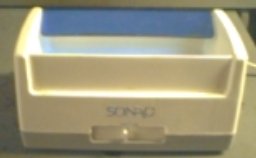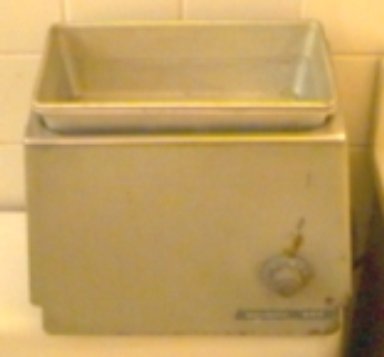Sonic cleaners are vibrating tanks containing solvents which remove contaminants from surfaces fairly rapidly. In various shapes, sizes range from about a cup to hundreds of gallons. Basic operation is very simple. A power oscillator circuit drives a transducer affixed to tank side, vibrating it and in turn it vibrates liquid inside. Frequencies may range from audio on inexpensive models to higher ultrasonic. Similar to those used in buzzers, pagers and alarms, piezoelectric crystal transducers are frequently used at lower powers. Larger powers often use a solenoid coil similar to that on a loud speaker. The secret of success lies in the vibration process of fluid molecules known as decavitation , which produces thousands of tiny scrubbing bubbles. These dart around randomly at high speeds; into normally difficult to reach, crevices and holes, jarring loose and floating away contaminants. In some cases, bubbles are difficult to see, but suspended particles can be seen bobbing around with sudden long distance dashes.
With a given volume of liquid, cleaning time is inversely proportional to the power applied to it. Since there are more molecules to move, larger volume tanks require more power. Higher frequencies reduce molecular path lengths and distances between bubbles, thus increasing surface collisions per area, which accelerates cleaning. As with all expended mechanical energy, through various paths, the eventual result is heat. Careful attention is required, since in time, temperatures may exceed boiling points of liquids or damage plastics. The use of a timer is highly recommended.
Size and power will be dictated by need and budget. With longer cleaning time, small denture cleaners can handle many, too small to hold for scrubbing, items; such as detail castings. Shape may effect choice, since round or oval shapes limit usage. Rectangular solid shapes permit longer items to be diagonally slanted between corners and accept multiple containers better. Increase in power is only necessary to reduce time. If using caustic solvents, tank should be stainless steel and supporting structure finishes and surrounding area should be resistant.

Note: Adjust brightness and contrast for optimum viewing.
DENTURE CLEANER
Lid hanging off back.

Note: Adjust brightness and contrast for optimum viewing.
MEDIUM BRANSONIC CLEANER
9 3/8 X 5 3/8 X 4 INCHES. 10" DIAGONAL.
After 30 years abuse, cleaning repair and refinish work.
Loaf pans stored in top.
Timer/switch installed after mishap.

Note: Adjust brightness and contrast for optimum viewing.
LARGE SHOP SONIC CLEANER
.
At the expense of longer run times, often it is desirable to use auxiliary containers in tank, for quicker changes in solvents or simultaneous use in different batches. With a small reduction in speed, many common baking loaf pans fit rectangular tanks nicely and can be easily swapped. With greater reduction of speed, due to the dampening effect of glass and thickness, Pyrex type pans may be used. Although through expanded volume and relatively low exposed area to tank liquid, speeds may be greatly reduced; high containers can increase capacity. With lower durability, cut down to desired length, square lunch meat cans fit some tanks well, for multiple batches. With relatively low speeds and storage capability, square or rectangular based coffee jars fit well for multiple batches. With lids, solvents can be stored and items pre-soaked to soften coatings. Plastic containers absorb vibrations rather than transmit them. Filling tank with water should be done with filled containers in place to avoid overflow.
Although molecules at the surface jump short distances into the air, increasing evaporation , except for levels close to the brim, lids are not usually required. When containers are used in tanks, lids should not be sealed tightly, but should allow air to escape with expansion.
Some accessories are desirable. Plastic gloves are a necessity. Plastic tongs are useful for fishing. To avoid fishing in murky liquids, smaller items may be enclosed in mesh bags. Many kitchen gadgets are designed for dunking. For small items, a mesh tea ball works well. Many strainers can be modified. For larger items, small dishwasher baskets will provide easy immersion and lift out.

Note: Adjust brightness and contrast for optimum viewing.
SPRING HANDLE MESH TEA BALL

Note: Adjust brightness and contrast for optimum viewing.
TWO LEVEL DISH WASHER BASKET, 4" X 7 1/2" X 3"
Dividers and studs hold many items securely.
Second clear level, behind closed center divider in top half of image.
Solvents come in all types, quantities and prices. Although, to remove oils, greases and loose dirt, the most common and least expensive is detergent and water, some detergents quickly foam and bubble from the agitation. This is not usually a serious problem unless spillage occurs. Low foam types are preferred. For more stubborn cases and better cleaning, many commercial and possibly toxic, solvents are offered, usually in 5 gallon cans from about $20 up. This should provide years of cleaning for the average modeller. A common battery or hand operated siphon pump eases transfer. Many of solvent systems require multi-step processing with neutralizing rinses. For paint removal, the least expensive solvent with mostly excellent results, is a strong mixture of lye (sodium hydroxide) and ammonia (ammonium hydroxide). Although it can darken and peel skin, it is safe on styrene and most metals. Longer immersion will etch zamac and brass for better adhesion, but some older poor quality zamac may flake and deteriorate. Thorough rinsing is always necessary, since some reactions continue on what may appear to be a clean, dry surface.
Due to constant use of water, unit should be located near a source and drain.
BACK TO METHODS INDEX
BACK TO PREPARATION
BACK TO TOOLS INDEX
